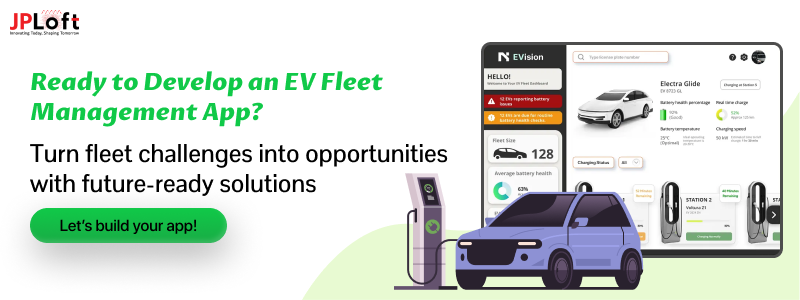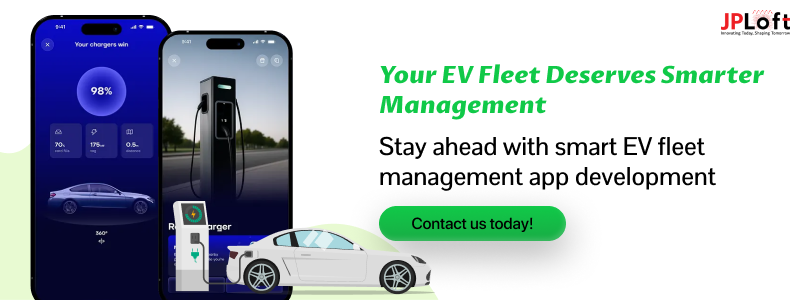Key Takeaways
EV fleet management apps simplify tracking, charging, and battery monitoring while boosting efficiency and sustainability.
If you want to develop an EV fleet management app, add core features like real-time tracking, battery monitoring, route optimization, driver analytics, and smart charging to improve operations.
To develop a successful and custom fleet management app start from research and tech stack to integration, testing, and deployment, every phase ensures smooth launch
The cost while building an EV fleet management app can range from $20,000 to $130,000+, depending on features and scale.
Smart Monetization models like subscriptions, freemium add-ons, charging commissions, data monetization, and white-label licensing drive profitability.
As a trusted Electric Vehicle software development company, JPLoft delivers scalable, secure, and innovative EV fleet management apps tailored to business needs.
“The future belongs to those who believe in the beauty of their dreams,” Eleanor Roosevelt once said and today, that dream is turning greener with electric vehicles (EVs) leading the way.
As businesses worldwide embrace sustainability, managing fleets efficiently has become more critical than ever.
According to recent reports, the global EV fleet market is projected to surpass $900 billion by 2030, highlighting the growing demand for smarter solutions.
So, if you’re planning to create an EV Fleet Management App, you’re not just creating a tool, you’re building the backbone of future mobility.
In this blog, we’ll explore how to develop an EV fleet management app, its key features, costs, challenges, and future opportunities to help you build a successful solution.
What is an EV Fleet Management App?
An EV fleet management app is a smart digital solution designed to help businesses efficiently manage their group of electric vehicles. Unlike traditional fleet management systems that mainly track fuel usage and mileage.
This app focuses on the unique needs of electric mobility, such as battery health, charging schedules, route planning, and energy consumption.
Popular solutions like Geotab, Samsara, and Fleet Complete already dominate the market, proving how impactful these platforms can be in transforming fleet operations.
EVs are connected through GPS, IoT sensors, and telematics, which send real-time data (like location, speed, and battery status) to a central dashboard. Fleet managers can then track vehicles, plan charging stops, optimize routes, and analyze performance all in one place.
In the broader scope of Electric Vehicle software development, an EV fleet management app bridges technology with sustainability, helping companies cut costs and move towards eco-friendly goals.
For businesses exploring how to create an EV fleet management app, this foundation provides a clear understanding of its working and real-world impact.
Why Do Businesses Need an EV Fleet Management App?
If you are wondering how to develop an EV fleet management app, the first step is understanding why businesses actually need it. Electric vehicle fleets bring unique challenges that go beyond what traditional fleet systems can handle.
Here are the top reasons companies are investing in such apps:
- Smart Charging & Battery Monitoring: EVs depend on battery health and charging schedules. A fleet app ensures real-time monitoring of battery status, prevents overuse, and reduces charging downtime with intelligent scheduling.
- Route Optimization & Productivity: Unlike fuel-based vehicles, EVs have range limitations. An app helps in planning routes with charging stops, cutting delays, and maximizing efficiency on every trip.
- Cost Reduction & Operational Efficiency: By tracking driver behavior, vehicle usage, and maintenance needs, companies can lower fuel (energy) costs, avoid unexpected breakdowns, and extend EV lifespan.
- Growth & New Opportunities: Beyond fleet tracking, such apps allow businesses to explore new services, like starting a mobile EV charging venture, unlocking revenue streams in the fast-growing EV ecosystem.
In short, building an EV fleet management app is no longer just an option, it’s a business necessity. If you want to start a mobile EV charging business, it will provide you huge opportunities to grow, expand your services, and tap into the rapidly increasing industry.
Key Features of an EV Fleet Management App
When you decide to make an EV Fleet Management App, understanding the essential features is crucial. The right app not only improves efficiency but also helps reduce costs, monitor performance, and ensure sustainability.
From real-time tracking to predictive maintenance, the features of EV apps are designed to simplify fleet management while providing actionable insights for better decision-making.
Here’s a detailed look at the key features:
|
Feature |
Description |
Benefits |
|
Real-time Vehicle Tracking |
Track EV locations and movements using GPS and telematics. |
Ensures timely deliveries, prevents misuse, and optimizes routes. |
|
Battery Monitoring & Management |
Monitor battery levels, charging status, and energy consumption. |
Avoids downtime, prevents battery overuse, and extends vehicle life. |
|
Route Optimization |
Suggests the most energy-efficient routes. |
Saves time, reduces energy costs, and improves fleet efficiency. |
|
Driver Behavior Analytics |
Records speed, braking, and driving patterns. |
Encourages safe driving, reduces accidents, and lowers maintenance costs. |
|
Charging Station Locator & Scheduler |
Finds nearby charging points and plans charging schedules. |
Ensures uninterrupted operations and efficient fleet management. |
|
Reporting & Analytics Dashboard |
Provides detailed performance, cost, and utilization reports. |
Helps managers make data-driven decisions and improve ROI. |
These features make it easier for businesses to create an electric vehicle fleet management app that meets operational needs while staying eco-friendly.
To achieve this successfully, partnering with the best mobile app development company ensures your app is robust, scalable, and tailored to your business goals.
Steps to Develop an Electric Vehicle Fleet Management App
How to build an EV fleet management app that optimizes operations, improves efficiency, and supports sustainability is a very common question of all. The answer lies in the proper development steps.
The process might seem complex, but breaking it into clear, actionable steps makes it manageable. Here’s a quick overview of the development steps before we dive into details:
-
Market Research & Competitor Analysis
-
Define Features & Functionalities
-
Choose the Right Tech Stack
-
UI/UX Design
-
Backend & API Development
-
Integration with EV Fleet Systems
-
Testing & Quality Assurance
-
Deployment & Launch
-
Maintenance & Updates
Let’s explore each step in detail:
Step 1: Market Research & Competitor Analysis
Before you create an EV Fleet Management App, it’s essential to understand the market landscape. Research existing EV platforms and top competitors to analyze their features, user experience, and monetization strategies.
Pay attention to unique EV app ideas, which can give you insights into innovative functionalities to include in your app. This step ensures your app offers distinct EV fleet management solutions that stand out in a growing market.
By conducting thorough research, you also identify gaps and opportunities that can make your app truly valuable for businesses managing electric fleets.
Step 2: Define Features & Functionalities
Next, decide what your app will include. Consider the benefits of EV fleet management app features such as real-time tracking through an EV fleet tracking system, battery and charging monitoring via an EV fleet monitoring app, route optimization, driver performance analysis, and comprehensive reporting and analytics.
In this step, you also plan monetization possibilities and any extra modules, like integrating EV charging stations or enabling mobile EV charging business features.
By clearly defining these functionalities, you can build an Electric Vehicle fleet management app that meets operational needs, improves efficiency, and delivers an exceptional user experience.
Step 3: Choose the Right Tech Stack
Selecting the appropriate technologies is crucial for scalability and performance. For an electric vehicle fleet management software, you may consider using React Native or Flutter for the frontend, while Node.js, Python, or Java can power the backend.
For databases, options like MySQL or MongoDB are commonly used. Integrating APIs and IoT is essential for GPS, vehicle telematics, and charging station connectivity, while cloud services such as AWS or Azure handle real-time data processing.
Choosing the right technology ensures your app is robust, secure, and capable of efficiently managing a growing fleet of electric vehicles.
Step 4: UI/UX Design
A smooth, intuitive interface is vital for both fleet managers and drivers. The design should allow easy access to EV fleet monitoring app dashboards, alerts, and route planning.
Using app wireframing, you can plan simple navigation for multiple users and create a clear visual representation of vehicles and battery levels. During app prototyping, you can simulate alerts for charging schedules or maintenance needs to ensure the workflow is seamless and user-friendly.
A well-designed app not only enhances engagement but also improves usability, which is critical for long-term adoption.
Step 5: Backend & API Development
Now it’s time to build an EV Fleet Management App technically. The backend handles all operations, including data processing, storage, and real-time analytics.
Key integrations include EV fleet tracking system APIs for GPS and telematics, and charging station APIs for route and energy management are included.
To ensure smooth development and efficient handling of large volumes of fleet data, many businesses choose to hire dedicated developers who specialize in EV fleet management app development.
This approach guarantees that your app is robust, scalable, and capable of meeting complex operational requirements.
Step 6: Integration with EV Fleet Systems
Your app must seamlessly connect with EVs, sensors, and charging infrastructure to ensure real-time tracking of vehicles, battery monitoring with timely alerts, and predictive maintenance notifications.
Additionally, you can enhance functionality by choosing to develop an app like Plugshare, creating innovative solutions and driving the future of electric mobility.
Proper integration guarantees that your Electric Vehicle fleet management platform operates efficiently, providing accurate data and insights that help fleet managers make informed decisions.
Step 7: Testing & Quality Assurance
A critical step in EV fleet management app development is rigorous app testing. Evaluate the app for performance under heavy load, real-time data accuracy, security vulnerabilities, and compatibility with various EV models.
Thorough testing guarantees that your Electric Vehicle platform is reliable, secure, and ready for real-world deployment, ensuring a seamless experience for both fleet managers and drivers.
Regular updates and continuous monitoring after testing also help maintain optimal performance, address new challenges, and adapt to evolving fleet management needs.
Step 8: Deployment & Launch
Once the app is tested, it’s time to launch. Deploy it on app stores or internal enterprise platforms. Monitor early adoption and gather user feedback to make improvements. Consider launching an MVP (Minimum Viable Product) first to validate the concept and gather insights before a full-scale rollout.
After finalizing the app, make sure to submit an iOS app to App Store. Similarly, publish an app to Google Play Store to reach a wider audience.
Additionally, track initial performance metrics and user engagement to refine features and ensure a smooth experience for all users.
Step 9: Maintenance & Updates
Post-launch, regular updates, and app maintenance service are essential to keep your app relevant and efficient.
Ensure the app stays updated with new EV models and charging stations, enhanced EV fleet management solutions, and AI-driven features that contribute to the future of EV fleet management apps.
Continuous improvement helps your app remain competitive, address evolving business needs, and deliver the maximum benefits of an EV fleet management app to businesses, ensuring long-term success and user satisfaction.
By following this step-by-step guide to develop an EV fleet management app, businesses can make an EV fleet management app that is robust, efficient, and ready for the growing electric mobility market.
This approach ensures seamless operations, optimized fleet performance, and enhanced sustainability.
Tech Stack for EV Fleet Management App Development
Choosing the right app tech stack is one of the most critical decisions in EV fleet management app development. The right tools and frameworks ensure scalability, security, and smooth integration with various EV systems.
A well-structured stack makes it easier to create an EV fleet management app that is robust, user-friendly, and future-ready.
|
Component |
Technologies/Tools |
Explanation |
|
Frontend Development |
React Native, Flutter |
These cross-platform frameworks allow you to make an EV fleet management app accessible on both iOS and Android with a single codebase. They ensure smooth UI/UX and faster deployment. |
|
Backend Development |
Node.js, Python, Java |
Essential for building the server side of the Electric Vehicle fleet management software, handling data processing, analytics, and integration with EV systems. |
|
Database |
MySQL, PostgreSQL, MongoDB |
Databases store critical information such as fleet details, charging history, and driver data. Choosing the right database ensures fast queries and reliable data storage. |
|
APIs & IoT Integration |
GPS APIs, Telematics APIs, Charging Station APIs |
APIs enable seamless integration with EV systems. They support real-time tracking, battery monitoring, and energy management, turning your app into a complete EV fleet tracking system. |
|
Cloud Services |
AWS, Microsoft Azure, Google Cloud |
Cloud platforms provide scalability, secure storage, and real-time processing capabilities, which are vital for managing large fleets efficiently. |
|
Payments & Security |
Stripe, PayPal, Razorpay |
Payment gateways enable monetization models. Secure transactions are essential if you want to build an EV fleet management app with subscription or pay-per-use models. |
|
AI & Data Analytics |
TensorFlow, Power BI, Apache Spark |
Adding AI enhances predictive maintenance, route optimization, and demand forecasting, unlocking the benefits of EV fleet management apps and helping businesses stay ahead of competitors. |
By leveraging this tech stack, you can create a scalable and reliable solution that adapts to the dynamic EV ecosystem. Selecting the right combination also ensures your app aligns with the future of EV fleet management apps, enabling long-term growth and sustainability.
Moreover, choosing the right technologies early helps businesses better plan the stages and timeline of EV apps, ensuring efficient development and faster go-to-market.
Cost to Develop an Electric Vehicle Fleet Management App
One of the most relevant questions businesses ask is: “What is the actual cost to create an EV software?” The answer depends on factors like features, tech stack, team location, and app complexity.
On average, the cost to build an EV software ranges between $20,000 – $130,000+. A simple MVP may cost at the lower end, while a feature-rich, scalable solution with advanced integrations can push the budget higher.
Let’s break it down with an estimated cost table for better clarity:
|
App Type |
Estimated Cost |
Development Timeline |
|
Basic MVP EV Fleet App |
$20,000 – $35,000 |
2 – 3 months |
|
Mid-Level App (with advanced tracking & analytics) |
$40,000 – $80,000 |
4 – 6 months |
|
Enterprise-Grade App (AI, IoT, multi-integration) |
$90,000 – $130,000+ |
6 – 12 months |
Ultimately, the cost varies based on business goals, required features, and scalability needs. Investing in quality development ensures your app becomes a long-term asset, rather than a short-term expense.
How Long Does It Take to Develop an EV Fleet Management App?
The timeline to build an EV fleet management app depends on the features, complexity, and level of customization. A basic MVP with core functionalities can be developed faster, while a full-scale product requires more time.
Partnering with an experienced mobile app development company Denver can help you reduce development time while maintaining quality.
Let’s take a glance at it in short.
|
Type of App |
Features Included |
Estimated Timeframe |
|
MVP (Basic Version) |
GPS tracking, battery monitoring, route planning |
3–4 months |
|
Advanced App (Full Version) |
AI route optimization, predictive maintenance, analytics dashboard, third-party integrations |
6–9 months |
|
Enterprise Solution |
Multi-fleet management, automated billing, cloud integration, security modules |
9–12 months |
|
Custom App with Emerging Tech |
AI + IoT + Blockchain integration, real-time EV charging station marketplace, advanced reporting |
12–15 months |
With the right strategy and expert team, businesses can ensure timely delivery without compromising on scalability and performance.
Challenges in EV Fleet Management App Development
When businesses set out to develop an EV fleet management app, they often face multiple roadblocks that can impact the project’s success. Understanding the biggest EV challenges early on helps in designing smarter strategies.
Let’s look at the most common obstacles and how to overcome them.
► Integration with Multiple EV Models and Systems
Not all electric vehicles follow the same telematics or charging protocols, making it difficult to ensure seamless compatibility.
Solution: Build a flexible electric vehicle fleet management platform with API-first architecture, allowing integration with various OEMs and charging networks.
► Real-Time Data Processing
An EV fleet tracking system requires accurate, real-time data for battery health, routes, and charging needs. Handling large volumes of data is a major challenge.
Solution: Use cloud services like AWS or Azure, along with scalable backend frameworks, to ensure data accuracy and speed.
► Battery Monitoring and Predictive Maintenance
One of the biggest pain points in EV fleet management solutions is ensuring vehicle uptime by monitoring batteries and predicting failures.
Solution: Integrate IoT sensors and AI-driven algorithms to create a reliable EV fleet monitoring app that sends timely alerts.
► Data Security & Compliance
Since fleet apps deal with sensitive driver and vehicle data, breaches can cause major issues.
Solution: Use advanced encryption, role-based access, and regular audits to maintain trust and compliance.
► High Development Costs
The cost to build an app with advanced features may appear overwhelming for startups.
Solution: Start with an MVP and scale gradually, or hire mobile app developers to manage costs effectively.
Overcoming these challenges requires the right balance of technology, scalability, and innovation.
By adopting the best EV fleet management app development practices, businesses can unlock sustainable growth in the electric mobility sector.
Future of Electric Vehicle Fleet Management Apps
The future of EV fleet management solutions looks promising as new technologies reshape the industry. With growing adoption of electric mobility, companies are exploring innovative features to stay competitive.
Here are some EV app development trends that will define the future:
-
AI & Machine Learning: Smarter route optimization, predictive maintenance, and cost forecasting.
-
IoT & Telematics: Enhanced real-time insights into vehicle performance, driver behavior, and charging cycles.
-
Blockchain for Transparency: Secure transaction records for charging, fleet leasing, and energy credits.
-
Integration with Smart Grids: Fleet apps will balance demand and supply, making EVs part of future energy ecosystems.
-
Sustainability Metrics: Companies will track carbon savings and eco-footprints via electric vehicle fleet management software dashboards.
These EV app development trends show that apps will no longer be just about tracking fleets, they’ll become powerful electric vehicle fleet management platforms driving innovation, sustainability, and cost efficiency.
Businesses investing today will gain a competitive edge in tomorrow’s market.
Monetization Models for EV Fleet Management Apps
A crucial question for entrepreneurs is: “How EV apps make money?” The revenue potential is huge if the right monetization strategy is chosen.
Here are some proven models for EV fleet management app development:
1] Subscription Model
Offer tiered plans where businesses pay monthly or yearly for access to different features, such as route optimization, predictive maintenance, or advanced analytics.
This ensures predictable recurring revenue and allows businesses to scale features as they grow. Subscriptions are one of the most stable monetization strategies in EV fleet app development.
2] Freemium with Paid Add-Ons
Provide basic tracking and monitoring for free, while charging for premium modules like multi-fleet management or integration with the best EV fleet management software.
This model attracts new users quickly and converts them into paying customers once they experience the value of advanced features.
3] Commission on Charging Services
Integrate charging networks and earn a commission whenever drivers book a charging session via your EV fleet monitoring app. It’s a win-win model where businesses simplify charging for drivers while generating consistent transactional revenue.
4] Data Monetization
Aggregated fleet and driver data can be anonymized and sold to energy providers, city planners, or EV manufacturers, creating new revenue opportunities.
Such insights help stakeholders improve charging infrastructure, optimize city traffic, and enhance EV adoption rates.
5] White-Label Licensing
Offer your electric vehicle fleet management platform as a white-label solution forenterprises wanting a customized app under their brand.
This approach reduces development time for businesses while bringing you a high-margin licensing fee.
6] In-App Marketplace
Create a marketplace within the app where businesses can access EV-related services such as insurance, maintenance, or accessories and earn a share from partner providers.
This not only diversifies revenue streams but also transforms your app into a one-stop ecosystem for EV solutions.
By adopting these strategies, businesses can not only recover their initial investment but also ensure long-term profitability. Choosing the right monetization model ensures your app evolves into a sustainable business rather than just a utility.
Why Choose JPLoft for EV Fleet Management App Development?
When it comes to building cutting-edge EV solutions, JPLoft stands out as a trusted Electric Vehicle software development company with years of expertise. We specialize in crafting scalable, secure, and high-performing apps tailored to business needs.
From EV fleet tracking systems to AI-driven analytics, our team delivers customized solutions that ensure efficiency and growth. With a strong focus on innovation, we integrate IoT, AI, and cloud technologies to create future-ready platforms.
Partnering with us means gaining access to skilled professionals who prioritize quality, timely delivery, and post-launch support. Whether you want to create an EV fleet management app for startups or enterprise-level operations, we provide end-to-end services to help you succeed in the competitive EV industry.
Final Wrap-Up
Developing an EV Fleet Management App is more than just a tech project, it’s an investment in the future of sustainable mobility. From market research and feature planning to integration, monetization, and scalability, every step plays a vital role in success.
By following the strategies and insights shared in this guide, businesses can confidently develop an EV fleet management app that not only streamlines operations but also drives long-term profitability.
With the EV industry growing at record speed, now is the perfect time to innovate and build smarter, eco-friendly solutions that shape tomorrow’s mobility.
FAQs
It’s a digital platform that helps businesses manage electric vehicle fleets by tracking, monitoring, and optimizing routes, charging, and performance.
Start with market research, define features, choose the right tech stack, integrate EV systems, and work with experienced developers for scalability.
On average, it ranges between $20,000 – $130,000+, depending on features, tech stack, and complexity.
Challenges include range anxiety, charging infrastructure integration, real-time tracking, and ensuring scalability, but these can be solved with the right approach.
They generate revenue through subscription plans, usage-based pricing, data monetization, and partnerships with EV charging networks.













Share this blog